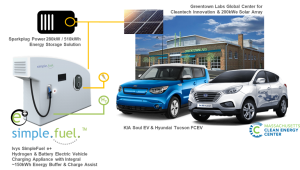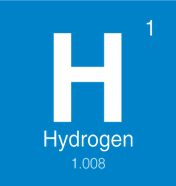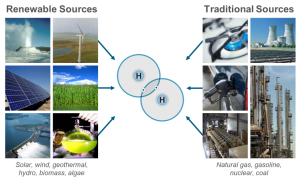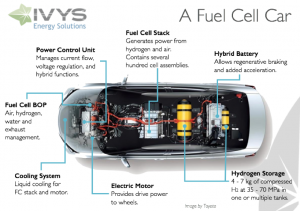The Greentown Labs community recently enjoyed an excellent Lunch & Learn presentation about hydrogen technology and safety by our very own in-house expert and member company, Ivys Energy Solutions. Later this year, and thanks in large part to a MassCEC InnovateMass Grant, Ivys will install its SimpleFuel® refueling station at our Global Center for Cleantech Innovation! The first of its kind, the station supports refueling of hydrogen fuel cell electric vehicles and charging of battery electric vehicles. The station will be integrated with a solar-based energy storage system—which will be owned and operated by two of our other member companies, Sunwealth (community solar investment firm) and Sparkplug Power (energy storage technology). More on those two technologies soon!

Led by Ivys’ Principal Engineer, Bryan Gordon, our community left the Lunch & Learn feeling informed, excited, and eager to drive a hydrogen fuel cell vehicle at our new facility in just a few months. We’re proud to learn all-things hydrogen safety and technology from Ivys because after all, they’re the experts! Their team led the SimpleFuel® consortium to win the Department of Energy’s $1M H2 Refuel H-Prize after successfully developing a safe, affordable, readily deployable hydrogen refueling appliance for fuel cell electric vehicles.
For those who are fairly unfamiliar with hydrogen fuel cell vehicles—don’t worry, you’re not alone! Here’s a brief summary of key takeaways from Bryan’s presentation:
Background refresher to get your bearings:
As you may recall from a chemistry class in years past, hydrogen is the simplest, smallest, and most abundant element in the universe. A gas at ambient conditions, hydrogen is  colorless, odorless, tasteless, and non-toxic. Hydrogen is also 14x lighter than air meaning if a leak occurs, gas rises very rapidly in air. Did you know hydrogen is an energy carrier, not an energy source? This makes hydrogen an ideal material to transport energy from one source to another. The energy content of 1kg of hydrogen is approximately equal to one gallon of gas (in BTUs)!
colorless, odorless, tasteless, and non-toxic. Hydrogen is also 14x lighter than air meaning if a leak occurs, gas rises very rapidly in air. Did you know hydrogen is an energy carrier, not an energy source? This makes hydrogen an ideal material to transport energy from one source to another. The energy content of 1kg of hydrogen is approximately equal to one gallon of gas (in BTUs)!
The combination of these characteristics make hydrogen fuel cell applications an excellent alternative to various traditional gas and diesel applications in the stationary, industrial, and mobility sectors. For stationary you can imagine hydrogen fuel cells being ideal for back-up power in office parks, medical institutions or for telecommunications companies. In the industrial space many major corporations from Walmart to Amazon to Sysco have adopted this technology for fork trucks, refrigerated trucks, airport tugs and similar equipment to significantly increase productivity by reducing battery change-out times from 15 minutes to less than 5. The mobility application—which we’re admittedly most excited about—can replicate today’s driving experience with more than 300 miles of range, zero emissions, and only 3-5 minutes of refueling time at retail hydrogen stations.
And for anyone concerned about the safety of hydrogen or hydrogen fuel cells: hydrogen is no more dangerous than many of the other chemicals we use in our day-to-day lives! In fact, private industry has used hydrogen safely for decades. Did you know 56 million metric tons/year are produced globally?! Nine million metric tons of which are produced in the U.S. alone! You’ll find more on hydrogen fuel cell vehicle safety in a section below.
How it works:
The most common method of hydrogen production is steam methane reforming of natural gas (or SMR), a process that splits natural gas and water into hydrogen. This is how industry has been producing hydrogen for decades.
Even though this process uses fossil fuel, it offers up to a 37 percent reduction in greenhouse gas emissions over gasoline vehicles when combined with fuel cell electric vehicles. This is due to the fact that hydrogen is produced and consumed by energy conversion, not combustion. Hydrogen production isn’t limited to just natural gas. Hydrogen can be produced either directly or as a byproduct from electricity or other fossil fuels such as coal and nuclear. Renewable sources such as electrolysis using wind or solar energy, geothermal, and biomass have the ability to provide long-term sources of hydrogen. Not only are these sources greener, but they diversify our country’s energy portfolio and offer greater energy independence.

There’s promising research for real-world demonstration of renewable hydrogen for both the point of energy used to make hydrogen and the source of hydrogen itself. That’s a longer-term goal and vision for the industry, for now, steam methane reforming will be the primary method of production. If you’d like some more details on how hydrogen fuel is made, we recommend this fun, quick YouTube video. If you’re more into reading, the California Fuel Cell Partnership (CaFCP) and Department Of Energy have great online resources as well.


Once you have the hydrogen fuel, it needs to go somewhere! That’s when the hydrogen station comes into play. A typical station consists of a dispenser and hydrogen infrastructure, and fills vehicles between 35-70 mega-pascals (5,000 to 10,000 pounds per square inch). The nozzle is different from the nozzle we use day-to-day at the gas station because it locks onto the vehicle for safety purposes while also grounding the vehicle. You’ll hear some different noises while refueling your hydrogen vehicle but don’t panic, these noises are mostly alerting you as to what’s happening. You’ll hear a whooshing noise, it’ll start and stop several times, and hear a brief but quiet relief of gas through the vent at the completion of a fill which is depressurizing the nozzle so you can remove it.
Where you can get a hydrogen fuel cell vehicle, and from whom:
Not surprisingly, California is leading the way on the hydrogen vehicle front but we’re working hard to catch up here in Massachusetts! California has nearly 30 public retail hydrogen fueling stations and 16 stations in the construction/installation phase. They have 350 fuel cell vehicles utilizing these stations and 18 transit busses in operation. Much of this progress can be attributed to the state’s forward-thinking energy policies and automotive OEMs including Toyota, Hyundai, and Honda.
The Northeast will soon have up to 12 refueling stations between D.C. and Montreal, so an expanded Northeast region. Three of these stations are planned for the greater Boston area!

Connecticut is leading in stationary fuel cell installations and has one hydrogen station opening this year. Additionally, the state is home to a large concentration of hydrogen companies which is helping push the entire industry forward.
Other states including New York and Hawaii are working to get hydrogen fueling stations to their communities and we’re eager to see which other states will follow! New York is scheduled to get a refueling station in the Bronx sometime this year.
To purchase your very own hydrogen fuel cell vehicle (if you’re in California), your best bet is to contact your local Toyota, Hyundai, and Honda dealerships as they’re the only automakers with a hydrogen vehicle on the market right now. It looks like BMW is working hard to release their own version of a hydrogen fuel cell vehicle, too.
How to stay safe:
The use of hydrogen isn’t new! It’s been used in industry for more than 50 years; we’ve seen the private industry successfully use it across eight major industries: fuel cells, semi-conductors, metal and chemical processing, power, plastics and rubber production, aerospace, food processing and pharmaceutical.
There are a couple things to note about hydrogen as compared to other fuels. First, hydrogen burns nearly invisible. Second, hydrogen has a low flammability limit, just 4 percent of hydrogen to air to create a flame. Third, hydrogen is 14X lighter than air, so if a leak were to occur the hydrogen gas quickly rises upwards. To mitigate these risks station designers install various safety devices which detect these hazards and isolate any flow of gas. Additionally the hydrogen industry is heavily regulated by multiple agencies that govern many aspects of the space from installation and permitting to design and materials selection. These regulations keep us and everyone utilizing hydrogen across industries safe! If you’re interested in knowing more about the regulations, we recommend checking out www.H2Tools.org for more info.
The most important safety tips you should keep in mind when refueling your hydrogen vehicle are the same safety steps you are likely (hopefully) already using while refueling your gas or electric vehicle! This means you don’t smoke while you’re fueling up, you don’t use your cell phone, and you turn your car off before you begin refueling. Simple as that! Additionally, anyone who plans to use a hydrogen refueling station must go through thorough training to ensure proper usage.

In the incredibly rare case that something happens while you’re refueling, here are some tips to keep in mind: stay calm! You’ll quickly realize something is happening because even the tiniest of leaks will make a loud sound. Your station will set off alarms and you’ll see some blowing debris—basically, you can’t miss it if hydrogen is being released. Once you identify that something has gone wrong, back away from equipment at a 45˚ angle from the source of the leak, engage the remote emergency stops, and alert your safety personnel. If there’s a fire, don’t try to put it out. That would allow the hydrogen gas which was just burning, to now release and accumulate, so then if that ignites you’d have an explosion versus just the fire.
Where to see one in person:
At Greentown Labs! Our new headquarters, the Global Center for Cleantech Innovation, located at 444 Somerville Ave., Somerville, MA, will have an Ivys refueling station and two Hyundai Tucson Fuel Cell Electric Vehicles. Once Ivys’ station is installed we’ll share another update about the installation and permitting processes and the fleet-sharing guidelines our community will follow.
If you’d like to know more about how to successfully utilize a hydrogen fuel cell vehicle, we encourage you to check out Ivys’ website or even better, please reach out. If you’re eager to see a hydrogen fuel cell refueling station in person, we look forward to welcoming you to our new facility later this year!


